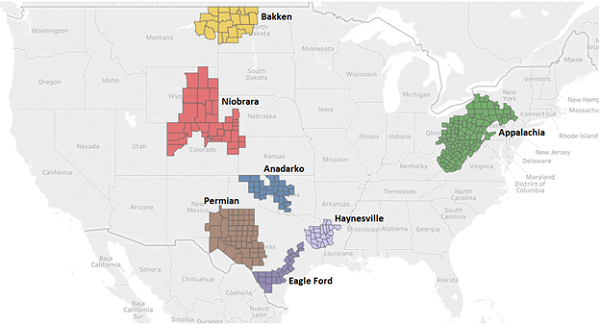
EIA Drilling Productivity Report Update – Nov ’19
According to the EIA’s November Drilling Productivity Report, U.S. oil output is expected to continue to increase through December. The Drilling Productivity Report uses recent data on the total number of drilling rigs in operation, estimates of drilling productivity, and estimated changes in production from existing wells to provide estimated changes in oil production for the seven key regions shown below.
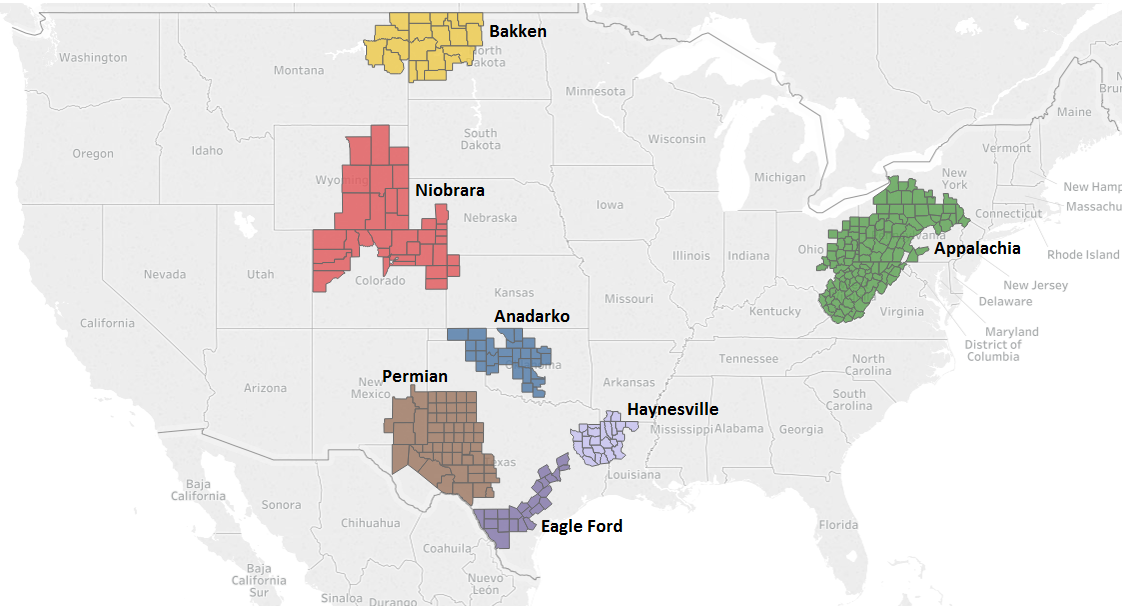 Nov ’19 production levels were revised 114,000 barrels per day (bpd), or 1.3%, above levels previously forecasted while finishing 65,000 bpd, or 0.7%, above Oct ’19 production levels. Dec ’19 production levels are expected to increase an additional 48,000 bpd, or 0.5%, from the Nov ’19 revised production levels to 9.13 million bpd, finishing at the highest figure on record. Dec ’19 production forecasts are expected to finish higher on a YOY basis for the 33rd consecutive month, up 10.8% from the previous year levels. The YOY increase in production forecasts was the smallest experienced throughout the past 28 months, however.
Nov ’19 production levels were revised 114,000 barrels per day (bpd), or 1.3%, above levels previously forecasted while finishing 65,000 bpd, or 0.7%, above Oct ’19 production levels. Dec ’19 production levels are expected to increase an additional 48,000 bpd, or 0.5%, from the Nov ’19 revised production levels to 9.13 million bpd, finishing at the highest figure on record. Dec ’19 production forecasts are expected to finish higher on a YOY basis for the 33rd consecutive month, up 10.8% from the previous year levels. The YOY increase in production forecasts was the smallest experienced throughout the past 28 months, however.
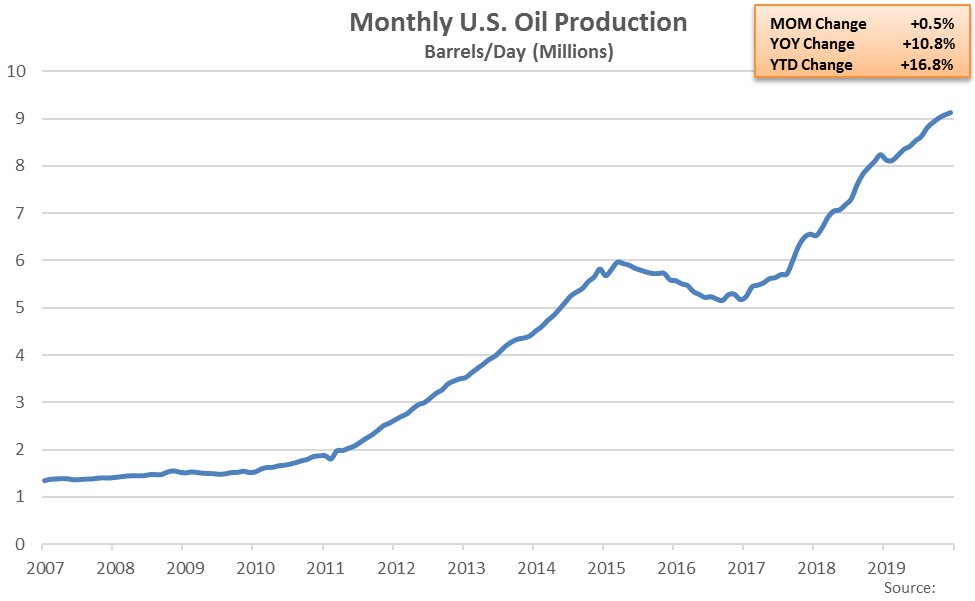 The Dec ’19 projected MOM increase in oil production would be the 21st experienced throughout the past 23 months but the smallest experienced throughout the past ten months on an absolute basis.
The Dec ’19 projected MOM increase in oil production would be the 21st experienced throughout the past 23 months but the smallest experienced throughout the past ten months on an absolute basis.
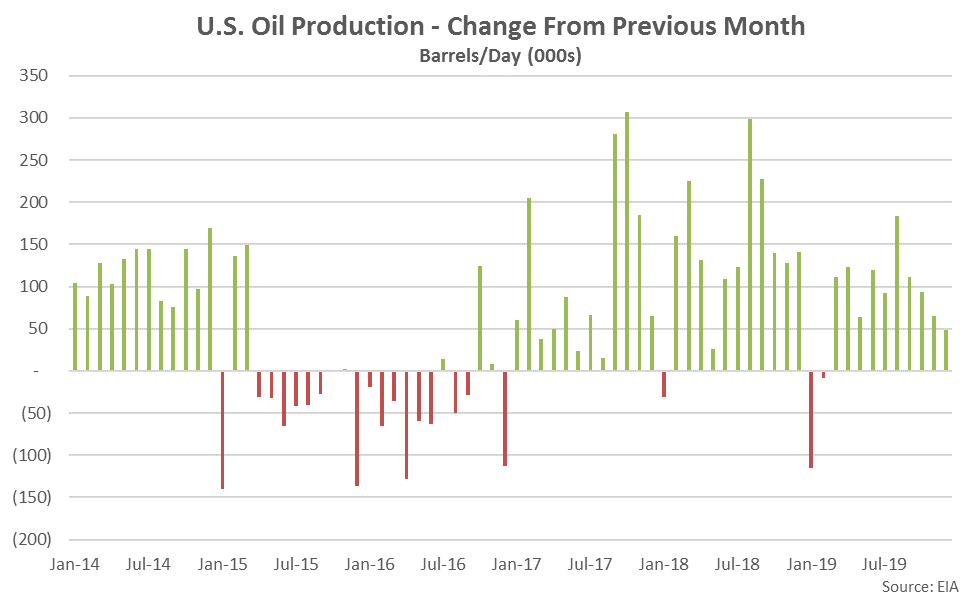 Oil production is expected to remain particularly strong within the Permian region, increasing by 1.2% on a MOM basis and more than offsetting a 0.2% MOM decline in expected oil production throughout the six other key regions.
Oil production is expected to remain particularly strong within the Permian region, increasing by 1.2% on a MOM basis and more than offsetting a 0.2% MOM decline in expected oil production throughout the six other key regions.
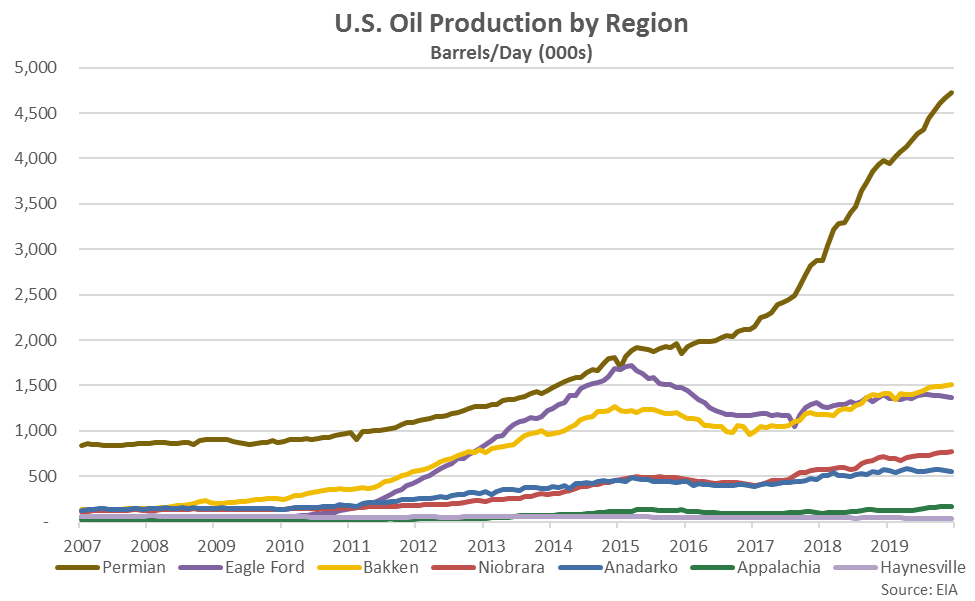 U.S. drilled-but-uncompleted (DUC) wells continued to decline from the Mar ’19 record highs, however, finishing lower for the fifth consecutive month. DUC wells, which have been drilled by producers but have not yet been made ready for production, have been compiled since Dec ’13. The Oct ’19 DUC wells figure of 7,642 finished 2.9% below the previous month, reaching a 12 month low level. The MOM decline in DUC wells was the largest experienced on record on an absolute basis.
U.S. drilled-but-uncompleted (DUC) wells continued to decline from the Mar ’19 record highs, however, finishing lower for the fifth consecutive month. DUC wells, which have been drilled by producers but have not yet been made ready for production, have been compiled since Dec ’13. The Oct ’19 DUC wells figure of 7,642 finished 2.9% below the previous month, reaching a 12 month low level. The MOM decline in DUC wells was the largest experienced on record on an absolute basis.
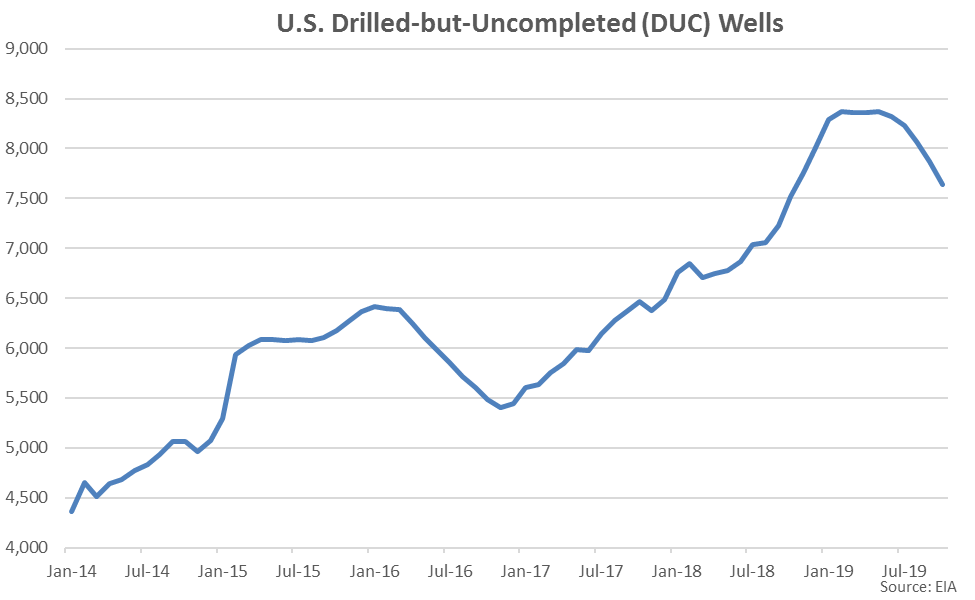 Anadarko DUC wells declined most significantly from the previous month, followed by Permian and Eagle Ford DUC wells. The aforementioned regions accounted for nearly two-thirds of the total MOM decline in DUC wells.
Anadarko DUC wells declined most significantly from the previous month, followed by Permian and Eagle Ford DUC wells. The aforementioned regions accounted for nearly two-thirds of the total MOM decline in DUC wells.
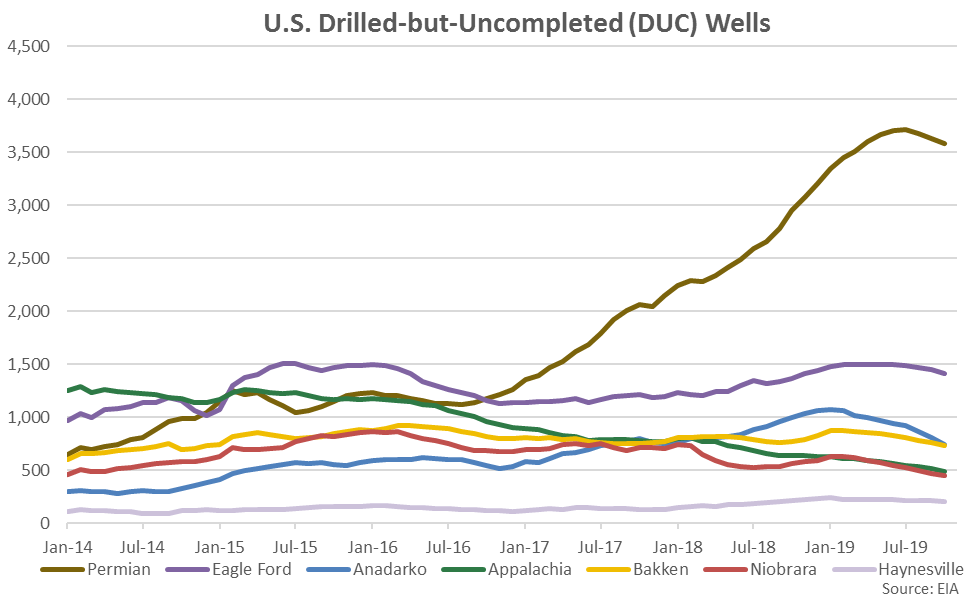
 Nov ’19 production levels were revised 114,000 barrels per day (bpd), or 1.3%, above levels previously forecasted while finishing 65,000 bpd, or 0.7%, above Oct ’19 production levels. Dec ’19 production levels are expected to increase an additional 48,000 bpd, or 0.5%, from the Nov ’19 revised production levels to 9.13 million bpd, finishing at the highest figure on record. Dec ’19 production forecasts are expected to finish higher on a YOY basis for the 33rd consecutive month, up 10.8% from the previous year levels. The YOY increase in production forecasts was the smallest experienced throughout the past 28 months, however.
Nov ’19 production levels were revised 114,000 barrels per day (bpd), or 1.3%, above levels previously forecasted while finishing 65,000 bpd, or 0.7%, above Oct ’19 production levels. Dec ’19 production levels are expected to increase an additional 48,000 bpd, or 0.5%, from the Nov ’19 revised production levels to 9.13 million bpd, finishing at the highest figure on record. Dec ’19 production forecasts are expected to finish higher on a YOY basis for the 33rd consecutive month, up 10.8% from the previous year levels. The YOY increase in production forecasts was the smallest experienced throughout the past 28 months, however.
 The Dec ’19 projected MOM increase in oil production would be the 21st experienced throughout the past 23 months but the smallest experienced throughout the past ten months on an absolute basis.
The Dec ’19 projected MOM increase in oil production would be the 21st experienced throughout the past 23 months but the smallest experienced throughout the past ten months on an absolute basis.
 Oil production is expected to remain particularly strong within the Permian region, increasing by 1.2% on a MOM basis and more than offsetting a 0.2% MOM decline in expected oil production throughout the six other key regions.
Oil production is expected to remain particularly strong within the Permian region, increasing by 1.2% on a MOM basis and more than offsetting a 0.2% MOM decline in expected oil production throughout the six other key regions.
 U.S. drilled-but-uncompleted (DUC) wells continued to decline from the Mar ’19 record highs, however, finishing lower for the fifth consecutive month. DUC wells, which have been drilled by producers but have not yet been made ready for production, have been compiled since Dec ’13. The Oct ’19 DUC wells figure of 7,642 finished 2.9% below the previous month, reaching a 12 month low level. The MOM decline in DUC wells was the largest experienced on record on an absolute basis.
U.S. drilled-but-uncompleted (DUC) wells continued to decline from the Mar ’19 record highs, however, finishing lower for the fifth consecutive month. DUC wells, which have been drilled by producers but have not yet been made ready for production, have been compiled since Dec ’13. The Oct ’19 DUC wells figure of 7,642 finished 2.9% below the previous month, reaching a 12 month low level. The MOM decline in DUC wells was the largest experienced on record on an absolute basis.
 Anadarko DUC wells declined most significantly from the previous month, followed by Permian and Eagle Ford DUC wells. The aforementioned regions accounted for nearly two-thirds of the total MOM decline in DUC wells.
Anadarko DUC wells declined most significantly from the previous month, followed by Permian and Eagle Ford DUC wells. The aforementioned regions accounted for nearly two-thirds of the total MOM decline in DUC wells.
